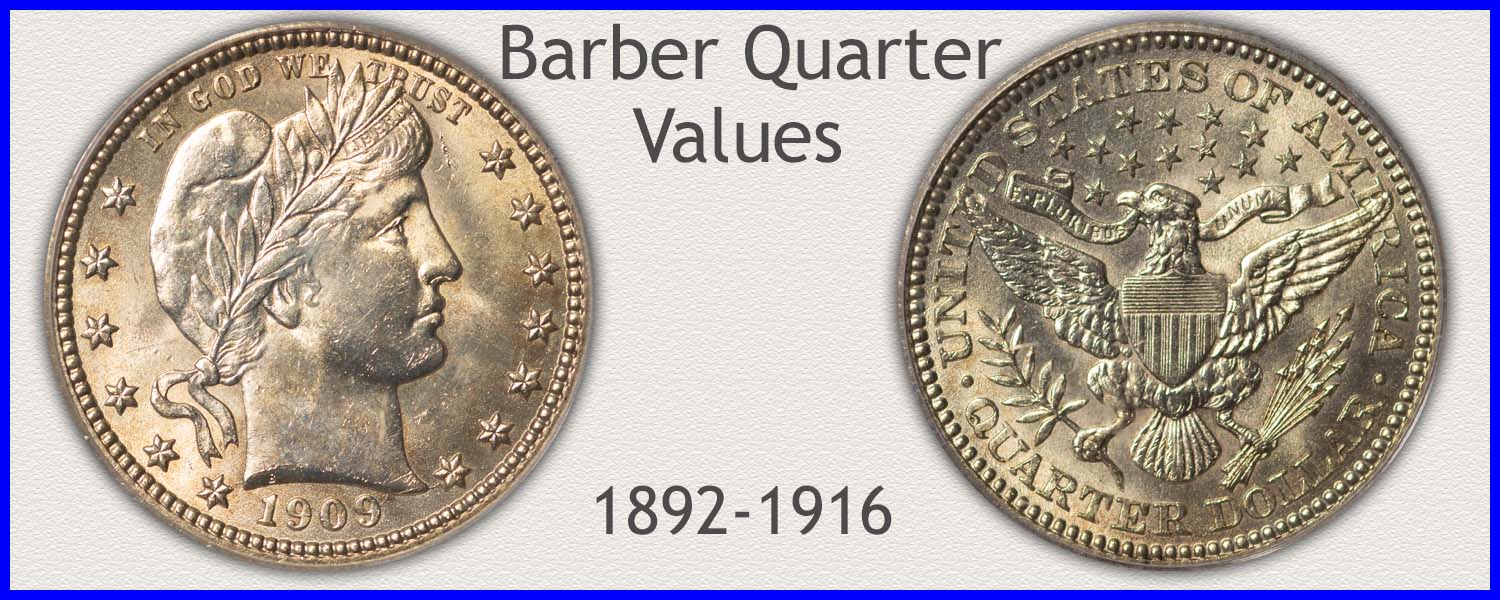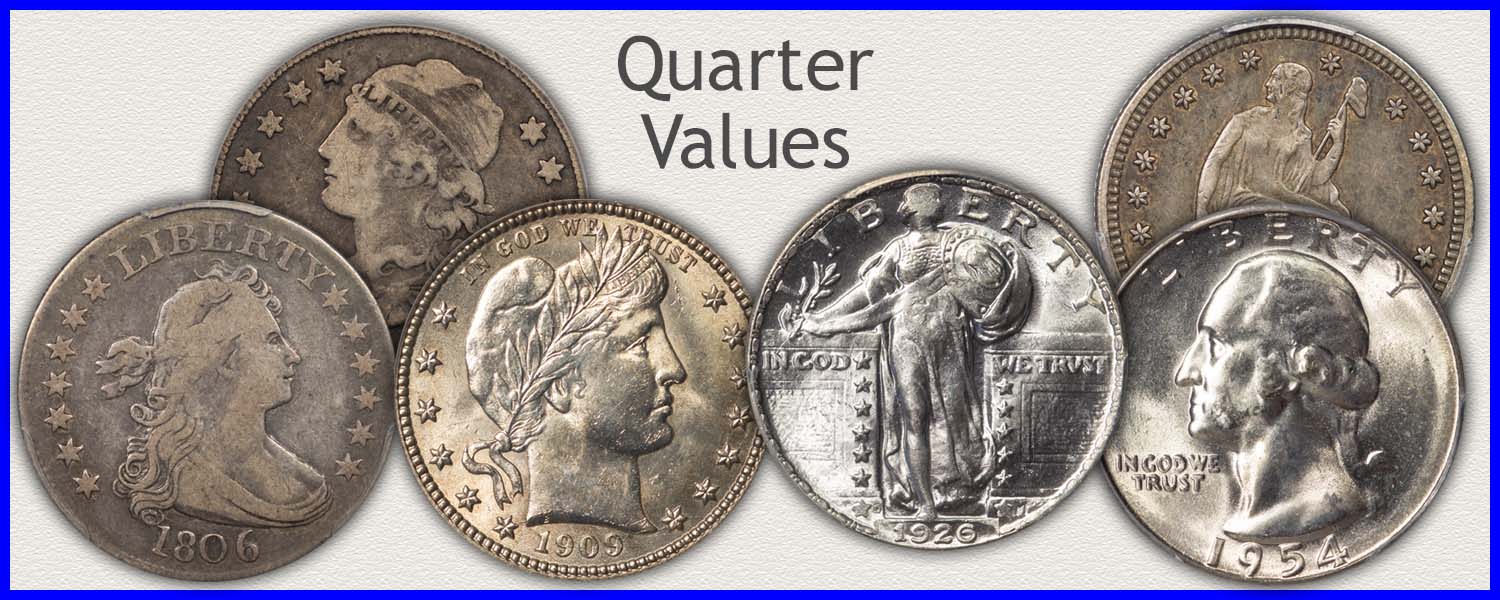Coin Values Moving with Precious Metals: Up-Dated 4/21/2025: Gold $3380 | Silver $32.89
1899 Quarter Value
1899 quarter value is determined by noting a few important features found on the coin.
The date of the coin, the mint that struck it, and the coin's overall condition are used to refine the values listed on the chart. Collectors value each of these factors, and are the hobbyists providing demand for Barber quarters.
A step-by-step approach is used to analyze the coin's important aspects. Verify the date, mint issue, and condition in order to narrow down the value of your quarter.
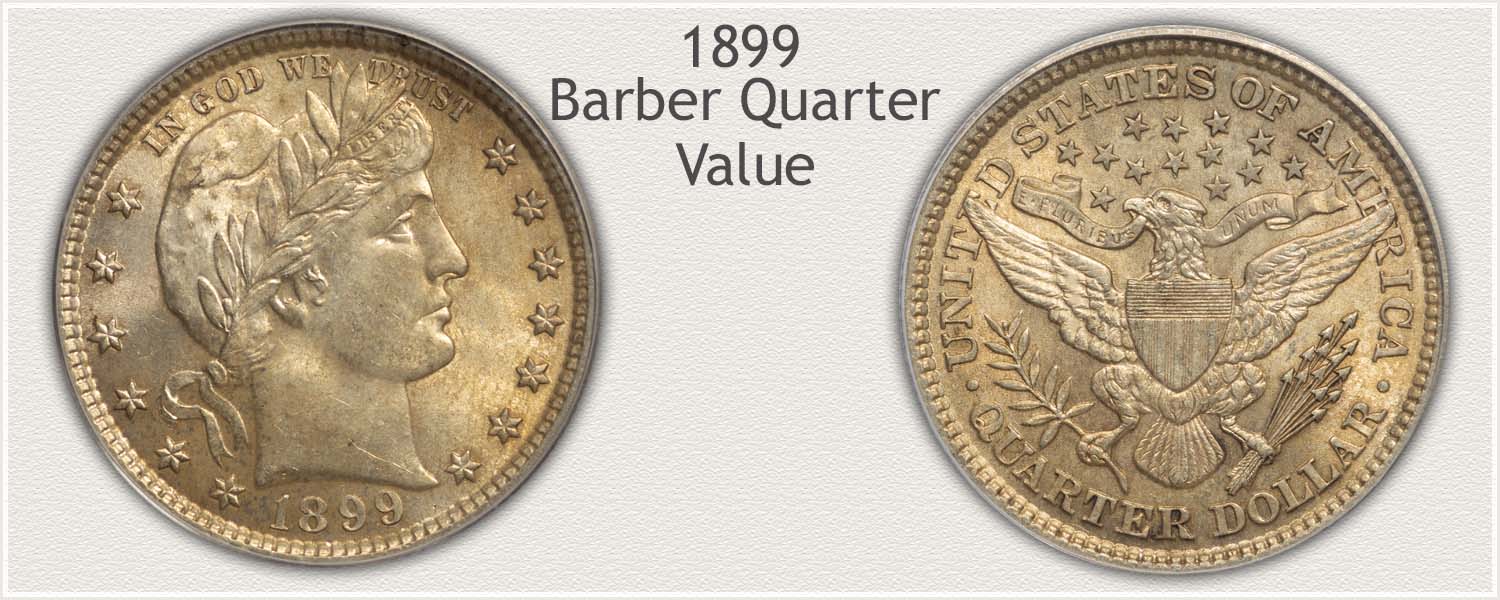
Steps Leading to Value:
- Step 1: Date and Mintmark Variety - Identify the exact variety of 1899 quarter by recognizing the three different mints that produced them.
- Step 2: Grading Condition - Using grading images that closely match your Barber quarter's condition helps narrow the value range on the chart.
- Step 3: Special Qualities - 1890's quarters are an older era coinage with special appeal to collectors. They are in solid demand.
| 1899 Quarter Value | ||||
|---|---|---|---|---|
| Condition of Coin | ||||
| Date | Good | Fine | Extremely Fine | Mint State |
| Barber Quarter Values Updated | 4/21/2025 | |||
| 1899 | $9.14 | $16 | $52 | $192 |
| 1899 O | $11.07 | $48 | $142 | $616 |
| 1899 S | $26 | $98 | $166 | Rare |
Values listed are a starting point to wholesale Barber quarter worth. Dealer demands plus a close eye to condition are important to recognize. Use the steps to narrow the value range.
Step 1: | Recognize Correct Date and Mint Issue Combinations
Three Mint Varieties of 1899 Quarters to Identify
Minted in 1899, a popular and uncommon mint variety leads in value. Issues from the San Francisco mint consistently contributed the fewest quarters to the annual total over the course of the Barber quarter series.
Mintmarks on coins produced by the branch mints are used to distinguish each mint variety and value it independently. To identify the correct date and mint combination, examine the images below.
1899-S Barber Quarter
"S" Mintmark on Reverse: San Francisco Mint Struck the Coin
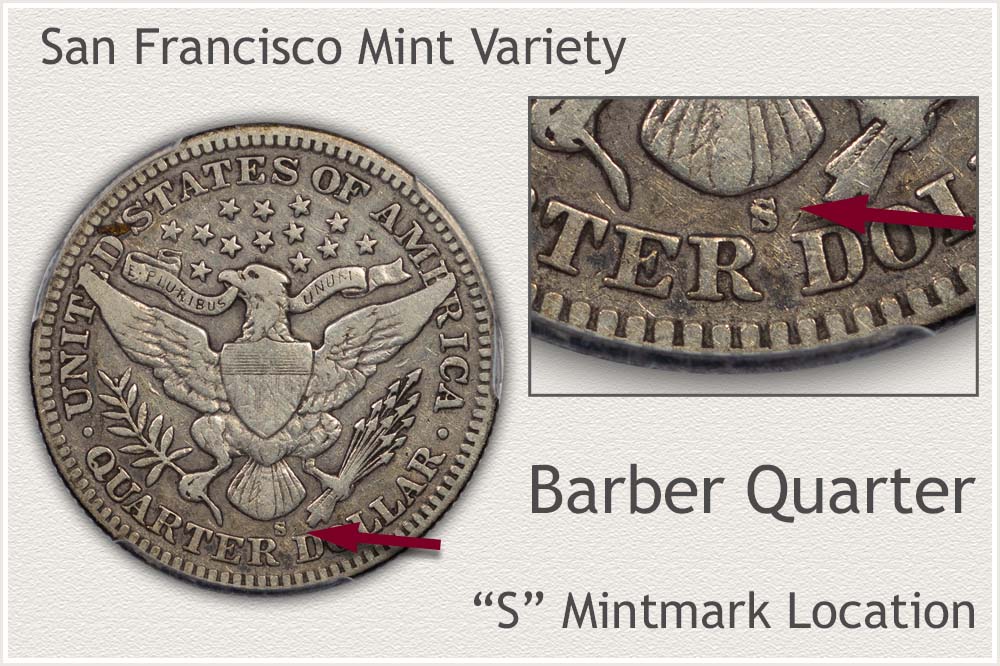
1899 is a significant year to collectors. It is the last year of the century and contains the San Francisco mint variety, with under one million coins struck. Only 708,000 were produced and placed into circulation. Any quarter in the Barber series with a mintage of less than one million is rare. This draws the attention of today's collectors, resulting in increased demand.
Historical significance as the last year of the nineteenth century, these are now a very old coin. Adding the appeal of under a million struck and the issue becomes a premium quarter.
Verifying the mint variety is the "S" mintmark on the reverse. Identification of San Francisco coinage is the "S" mark located between "Quarter Dollar" and below the eagle's tail feathers.
1899-O Barber Quarter
"O" Mintmark on Reverse: New Orleans Mint Struck the Coin
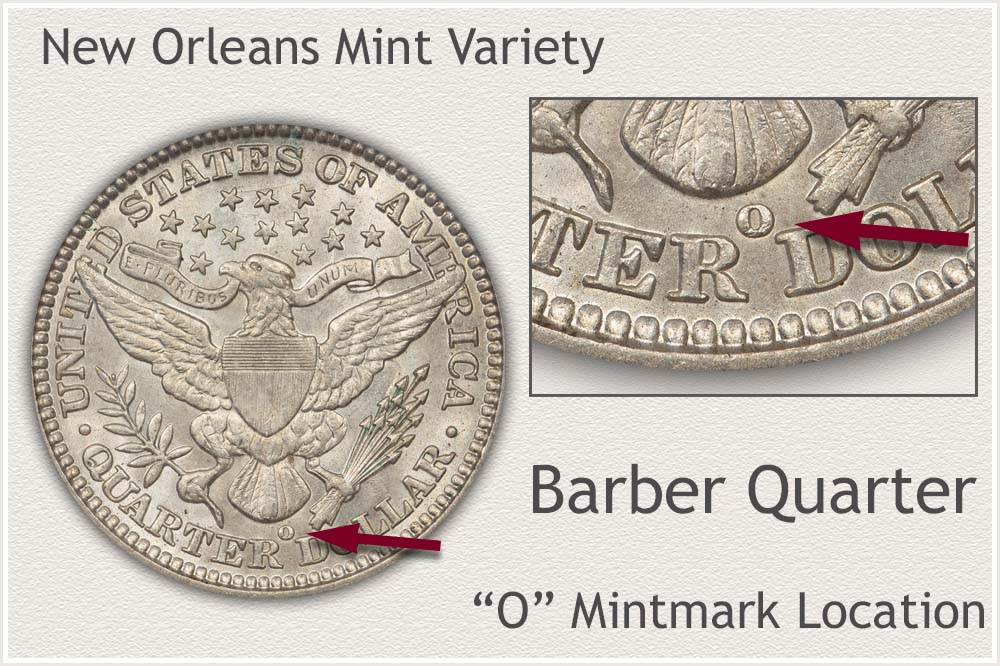
In 1899, the New Orleans mint played a vital role in the production of the Barber quarter series, as it supplied the nation's heartland. New Orleans produced more than 2,644,000 quarters, and combined with the Philadelphia production, supplied the majority of quarters minted in the year. Coin collectors pay a nice premium for an example with ample detail. Notably, well-worn pieces are also worth a small premium above base silver value.
The various mining facilities are recognized by their own mintmarks, which are placed on coins produced by these branch mints. On the reverse of a branch mint quarter, is a large letter "O" that serves as the New Orleans mint's identification.
Look for the New Orleans mintmark above the "R" and the "D" in "Quarter Dollar." A quarter struck by New Orleans mint, is determined by the "O" found just below the eagle's tail feathers.
1899 Barber Quarter
No Mintmark on Reverse: Philadelphia Mint Struck the Coin
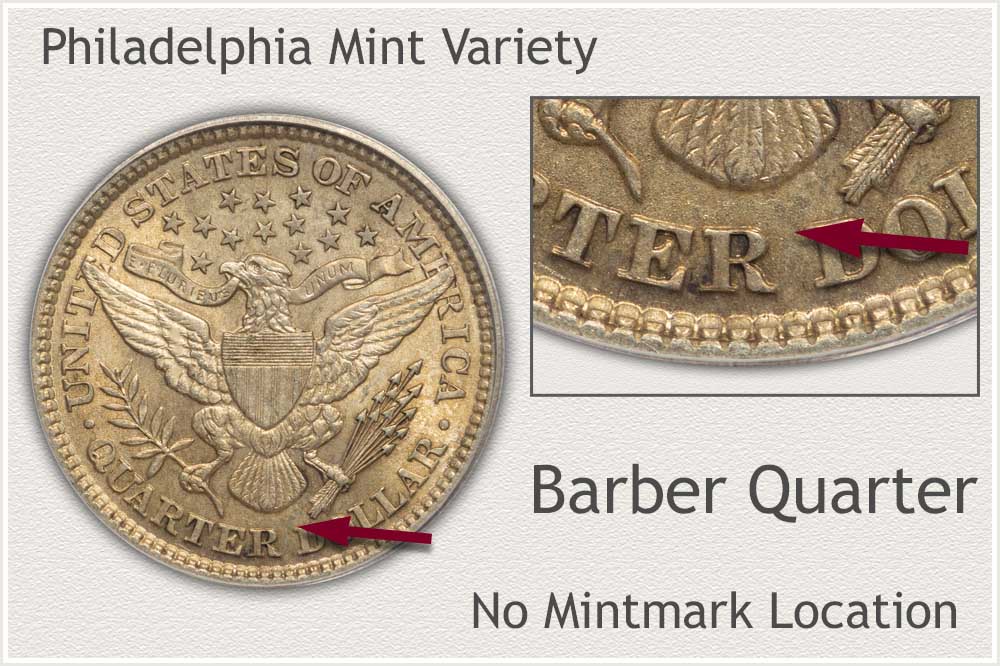
The abundant 1899 quarter today is the Philadelphia variety. These quarters were struck in excess of 12.6 million pieces. Far out numbering the two other mint's production. Many are sought by collectors because they represent an affordable year. Presious metals investors are also interested because of their silver content and they are priced close to base silver worth.
The chart highlights the significance of condition in identifying the higher quality, premium quarter. Although many are still available today, it is difficult to find a pleasing example of collector quality.
The primary U.S. mint is the Philadelphia facility in Pennsylvania. During the minting of the Barber series, no mintmarks were placed on coins by the mint. The typical mintmark placement area is empty identifying this mint issue. The Philadelphia mint issue is verified by the absence of a mintmark on the reverse, below the eagle's tail feathers.
Step 2: | Condition is Judged Determining a Coin's Grade
Judging Condition Recognizes Collectible 1894 Quarter Value
Subtle details separate one grade from the next higher. In a condition displaying finer details of the design, these old quarters increase in premium value.
Grading classifies the different stages of wear. Standards are compared to determine the narrow condition range within a specific grade. Images and descriptions of areas to judge cover the important features.
Mint State Grade
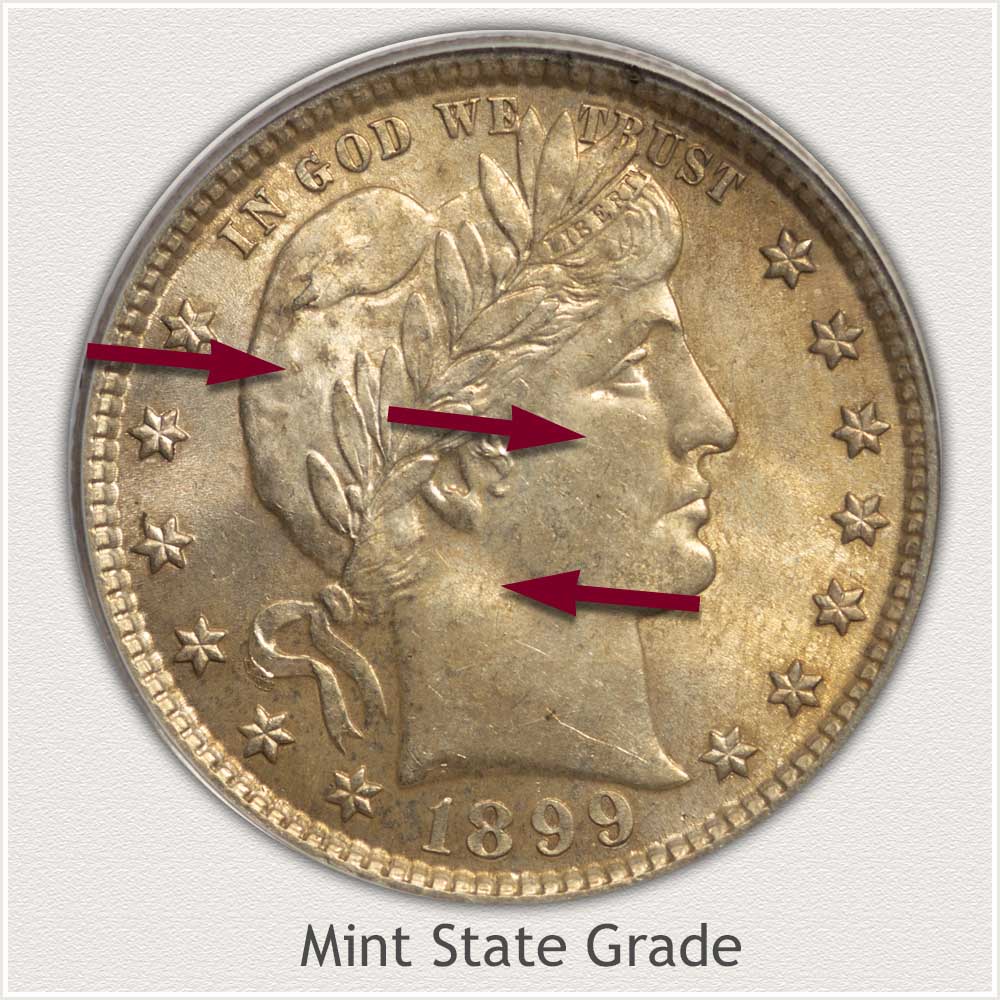
Mint State: For their collections, collectors try to obtain the best possible condition Barber quarter. Often this is a coin graded as mint state; still in the condition it left the mint. A high-quality coin defined as having no surface wear.
Examining a coin's luster is a reliable indicator of wear. Coins in mint state condition have full luster that remains and covers the design's high and low points. During the striking process, metal flows into the design elements. This metal movement results in a fine texture causing the surface to shine. Technique: Light golden toning has developed on the surface of this 1899 quarter. By moving and tilting it under a single light, the luster underneath shines "through" and moves with the lighting.
The exposed cheek of Liberty is susceptible to early signs of wear. Compare the area of high relief under her eye to the area of lower relief near her ear. There is no smoothing of the metal near the eye and both have a similar texture. She also displays the same texture and shine throughout her neck and cap. A nice example of a Barber quarter in mint condition is identified.
Extremely Fine Grade
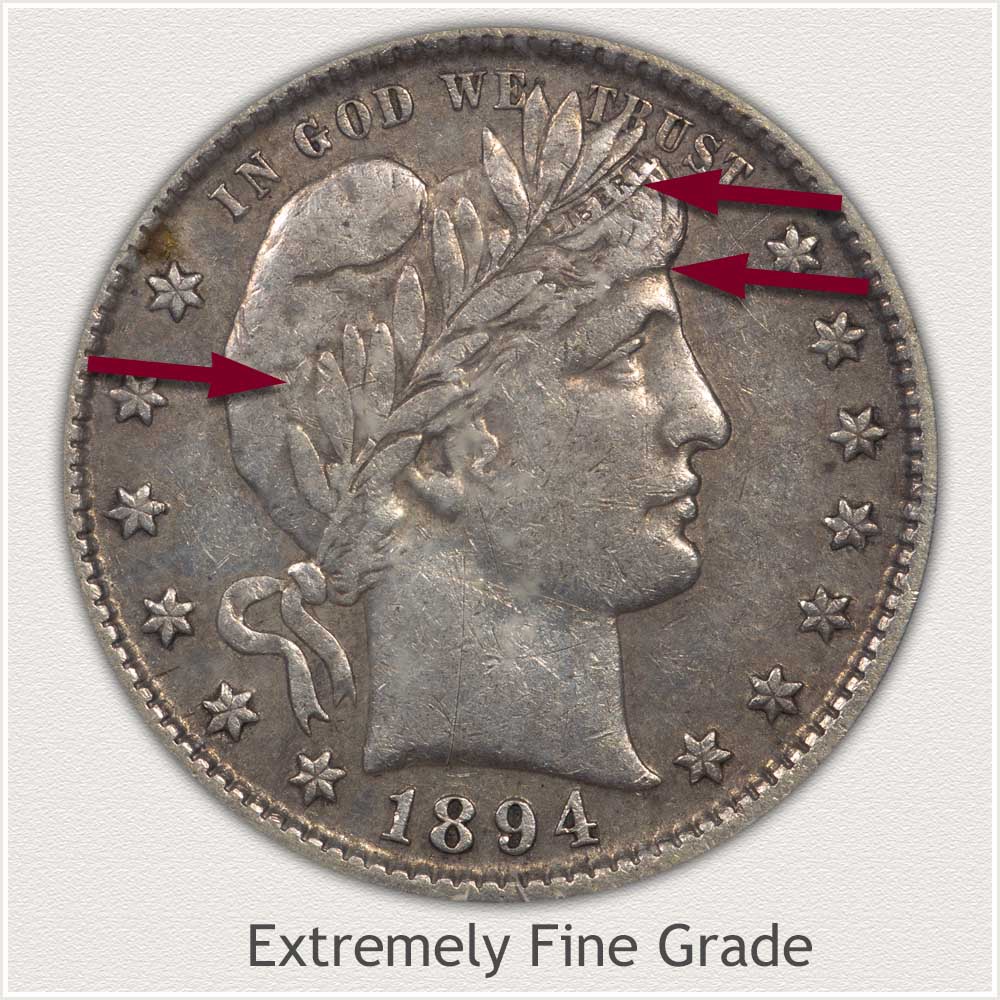
Extremely Fine: To grade Extremely Fine, a quarter shows only very minor signs of wear. These high condition Barber series coins are highly collectible and sought after by many collectors. The metal's original mint luster is now replaced with a soft silver-gray tone.
Liberty's hair just above her forehead is first to show early signs of wear. Fine hair strands were part of the original design, but many strands have flattened with slight smoothing. Examine the headband's lower edge as well as upper edges. This coin is considered within the grade because it has a clearly defined band distinct from the hair.
All leaves within the wreath are strongly outlined with high and low contours to the leaves, which is a significant characteristic of this grade. Edges of the leaves only show a slight amount of wear. Overall appearance of the coin is one of sharp detail. There are no major flaws to the surface, making this an attractive coin for a collection.
Fine Grade
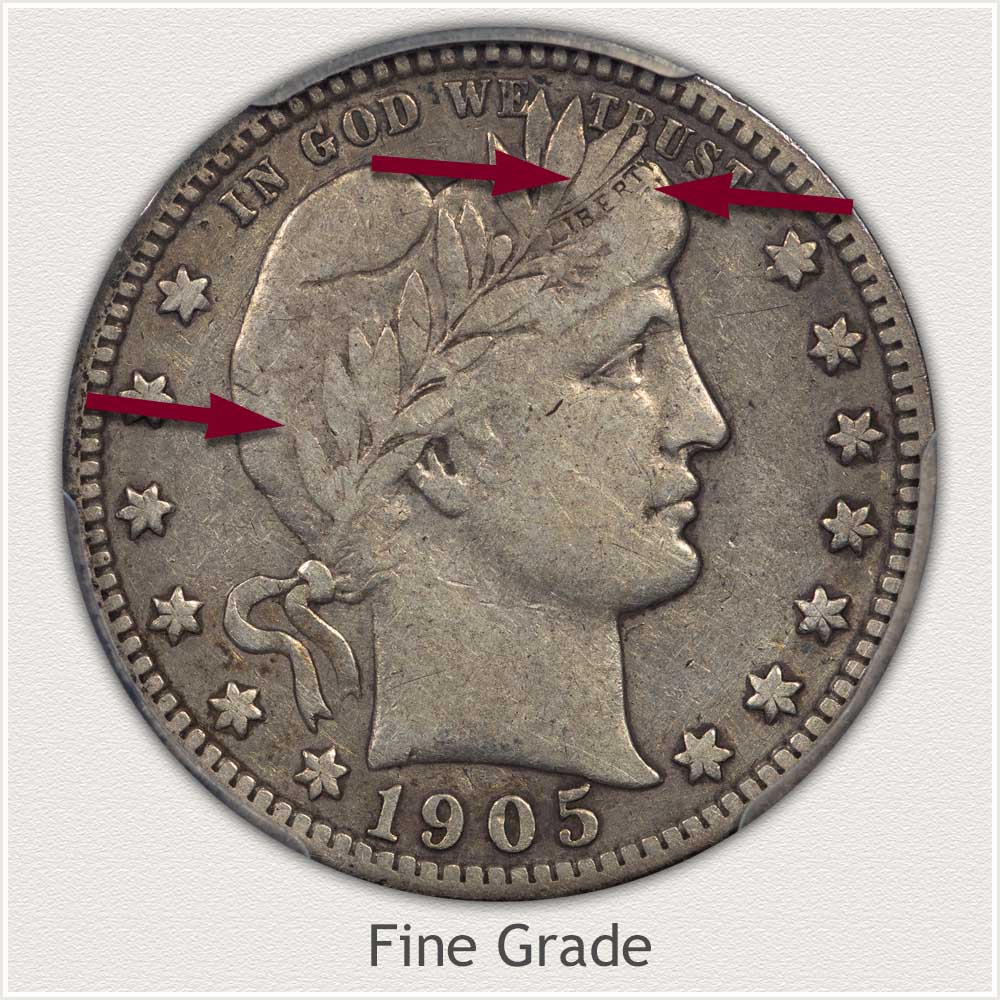
Fine Grade: A continued large collector base is a driving force behind the high premiums for these quarters. Quality of a Fine grade quarter is recognized by a moderately worn appearance with many of its original details still intact. These visually appealing coins of this vintage series feature a crisp level of detail.
The headband of Liberty with the lettering "LIBERTY" is one of the areas to inspect when recognizing a quality example. With all the letters visible, this coin qualifies for the Fine condition grade. Coins are considered solid for the grade if portions of the top and lower ribbon edges are still present.
Overall, most of the original small details have been worn smooth over time. The wreath's leaves no longer have high and low points; instead, display a flattened surface. Importantly, all the leaves in the upper row remain outlined, with just slight merging of edges. In the lower row, there is a clear blending of the leaf edges.
In terms of collector quality, a moderately worn coin without distracting marks or dents is a nice addition to a set.
Good Grade
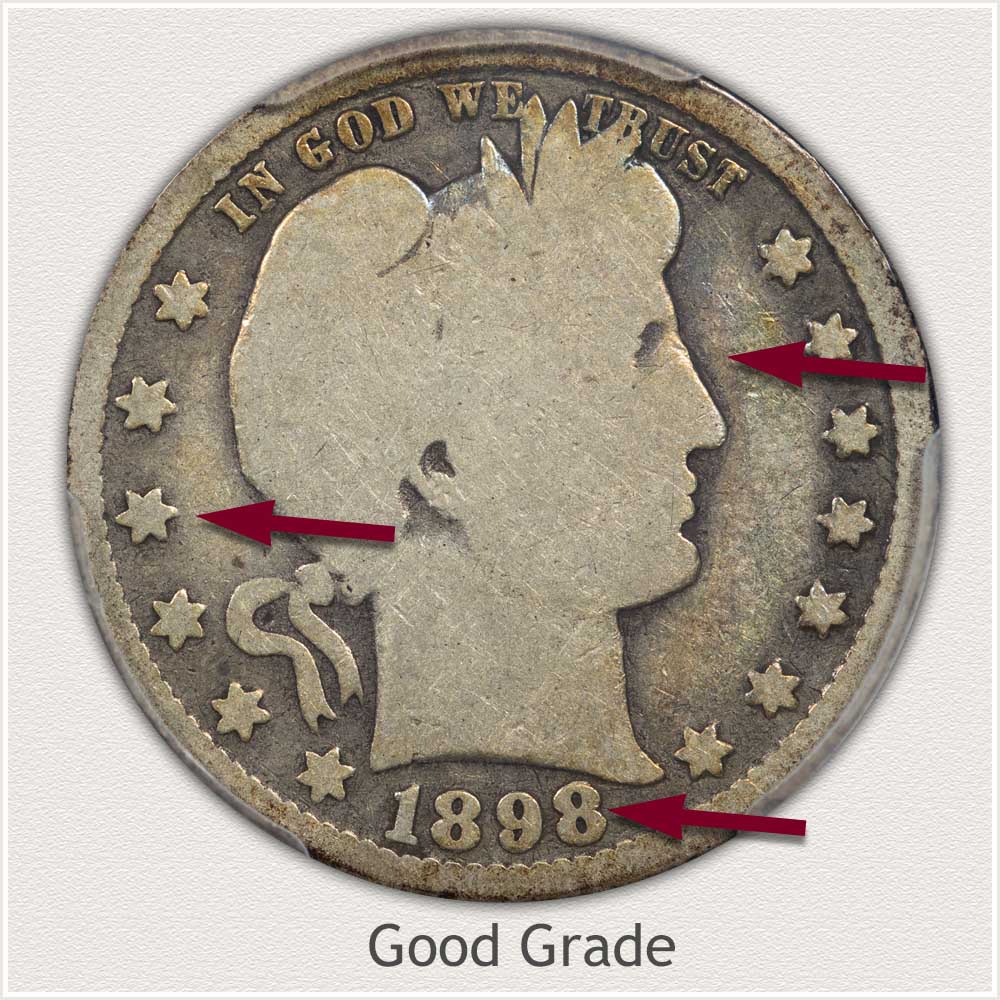
Good Grade: Three visible features are placing the example coin in a solid Good grade range. Of importance, a strong portrait is fully outlined and stands out from the background. Throughout the portrait, small details are worn smooth, leaving a flat outline. Second, the stars and rim are very bold. Finally, an easily legible date.
When the main devices are flattened to a flat surface, the grade is defined as Good. Examine the upper portion of the portrait. Confirm all the leaf edges are distinct and there is no blending with the rim or the lettering. A complete inner edge to the rim is also defined, separate and not connected to any star points. Complete stars and a rim that frames the portrait are a nice, bold detail.
Additionally, the date is disconnected from the rim. With added wear, the rim lowers and merges with the numerals. Consequently, merging lowers collector appeal. This a good overall representation of an old quarter.
How to Video: Grading Barber Quarters
Each grade has additional features highlighted in the video. Determine accurately your quarter's condition and separate it into a grade category.
Video, Images and Descriptions | Grading Barber Quarters
Step 3: | Special Qualities | Last of the Nineteenth Century
Collectible Appeal of 1899 Quarters
With the ending of the nineteenth and beginning of the twentieth century; coins dated in the 1890's became an "older" era coinage. Within the Barber quarter series, it is notable in value charts the appeal of nineteenth century dated examples all enjoy a premium.
Circulated quarters dated before 1900 are worth slightly above those of later years. Allure of an "older" coin is reflected in minimum values.
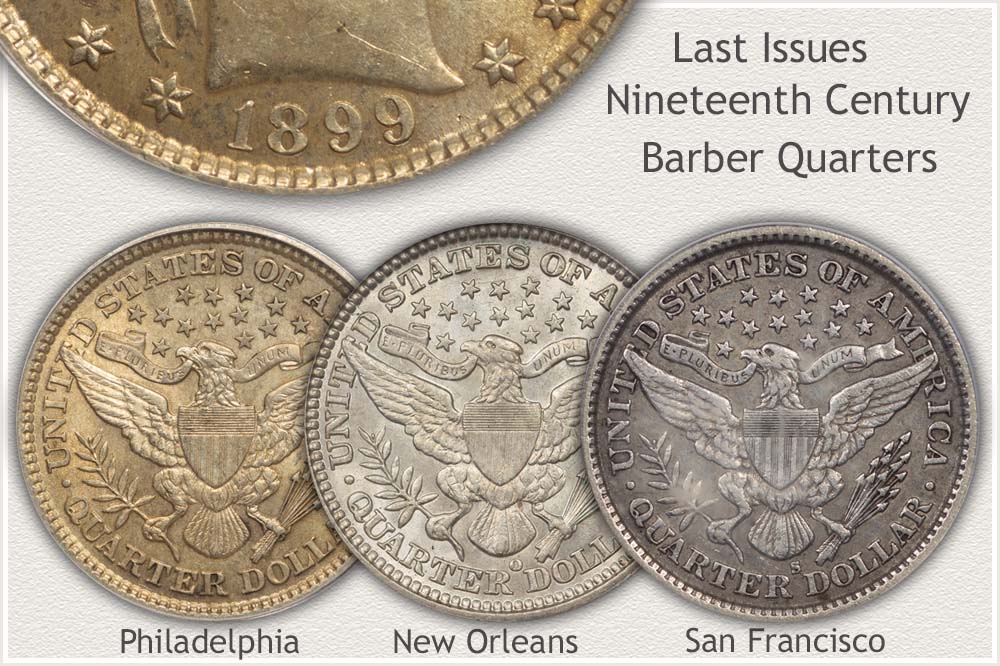
An attraction of Philadelphia mint 1899 quarters is their availability to many levels of collecting. A beginning collector finds entry to nineteenth century coinage affordable in a Philadelphia quarter.
New Orleans coinage is very popular with collectors. A now closed mint, an 1899-O quarter variety, is also an available coin, a very collectible example of the mint and sought by all levels of collecting.
San Francisco 1899 quarters are the scarce mint variety and an elusive coin. With a mintage under one million, it draws the added attention of being a very low production year. As a premium collectible, these San Francisco quarters present a challenging mint variety to collectors. Eye appealing examples with only light wear is a scarce coin.
1899 with its nineteenth century appeal and collecting challenges, is a special year of Barber quarters. A mint variety collection in Good condition is affordable and sought by new collectors. Advanced collections of high-grade examples is a worthy goal and builds a premium set of Barber quarters. Many collectors with many collecting themes are placing strong demand on 1899 and earlier quarters. This is a group of early era quarters with special qualities.
References
U.S. Mint. 1900 U.S. Mint Annual Report.
https://nnp.wustl.edu/library/book/320
U.S. Mint. 1916 U.S. Mint Annual Report
https://nnp.wustl.edu/library/book/514129
Coin Values | CoinStudy Articles
Date by Date
In Depth Barber Quarter Values
1892 to 1916
Barber Quarter Value | Many Scarce Dates
1899 is just one of twenty-five dates to the Barber quarter design series. Each is valued separately on the full value chart. Steps identifying date, mint, and condition lead to finding an accurate place on the chart.
Quarter Values | Scarce Series and Designs
Many appealing designs are part of the quarter denomination of U.S. coinage. Barber quarters were minted long after the first quarter in 1796. Bust and Seated quarters are the very early issues and highly valued. Identify your old quarter with images and links to the series.
Coin Value Guide | How to Value a Coin Collection
Starting with organizing a coin collection prepares for an accurate evaluation. Essential key factors are categorized in order and follow a method to accurately place a value on the collection.
Silver Coin Values | Minimum Values of U.S. Silver Coins
Silver was a base metal to U.S. coinage up to 1964. Many of these silver dimes, quarters, halves, and silver dollars are valued and traded today rising and falling with the price of silver. Using the calculator and current market price of silver, determine the minimum worth of the older 90% silver coinage.
Safe Coin Storage | Recommendations
High valued coins when properly stored are protected from handling, further damage, and remain in the same condition as when collected. Recommended are products available to collectors to house both single coins and multiple coins in groups.
Coin Grading Services | Professional Review of Your Coins
The series of coin, date and mint are evident on coins. Identifying the Grade of a coin is a skill of judging condition. When the potential of value is entering the hundred-dollar range and above, professional grading is often a good option. Subtle points to condition are expertly assessed. The top two services are reviewed.
★Coin Values Discovery finds 1899 Quarter Value and...
All old coin values. Images are used to follow a step-by-step method when determining how much U.S. coinage is worth.
